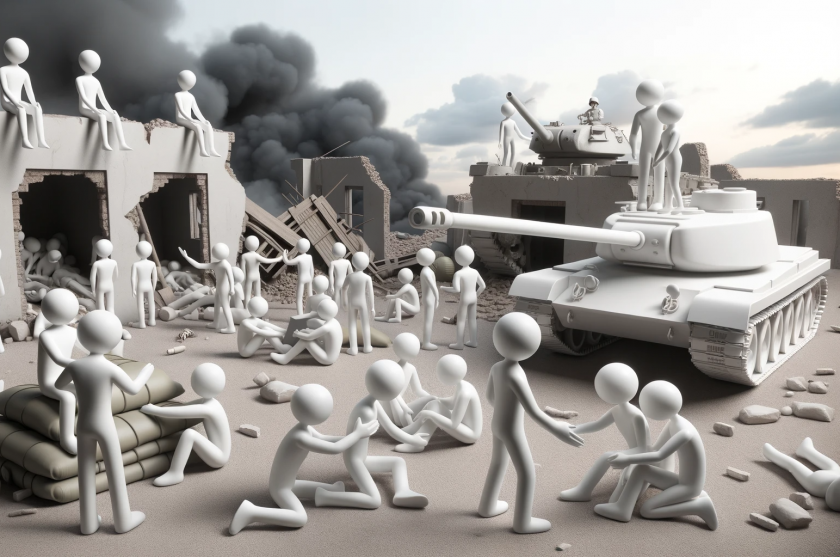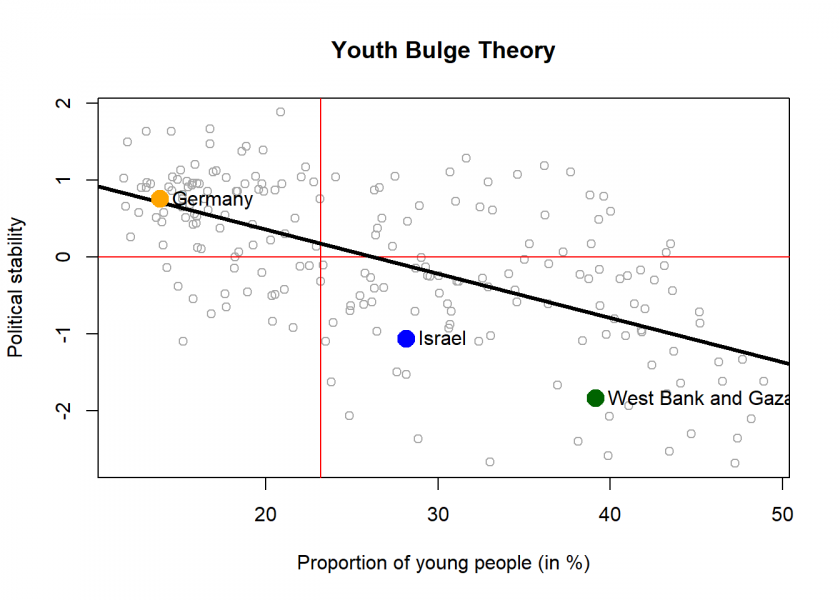
The geopolitics of the Middle East has always been complex, with its share of conflicts and political unrest. Numerous theories have been proposed to dissect the underpinnings of the region’s political instability.
One such theory, known as the Youth Bulge Theory, asserts that a high proportion of young people within a population can lead to political instability and even violence. This theory could provide an illuminating perspective on the dynamics of the Middle East conflicts.
If you want to understand this most important ingredient of the ongoing conflict, read on!
You can also watch the following analysis as a video (in German):
The Youth Bulge Theory posits that countries with a high percentage of young individuals are more susceptible to political instability and violence. The rationale behind this theory is that a large cohort of young people can create increased competition for limited resources like jobs and housing. If these needs remain unmet, the youth may become a fertile ground for political agitation, or worse, recruitment into extremist factions.
The Youth Bulge Theory was already extensively discussed on Learning Machines and used to analyse Afghanistan, Russia, and China.
To validate the Youth Bulge Theory, we can turn to data. By analyzing the proportion of young people against a political stability indicator across different countries, we might discern a pattern to substantiate this theory.
We’ve employed data from the World Development Indicators database, specifically focusing on the proportion of young people and a political stability indicator:
library(WDI) # install from CRAN
age0_14 <- WDI(indicator = "SP.POP.0014.TO.ZS", start = 2021, end = 2021) # proportion of 0-14 year olds
pol_stab <- WDI(indicator = "PV.EST", start = 2021, end = 2021) # political stability indicator
data <- merge(age0_14, pol_stab)[c(1, 5, 6)] |> na.omit()
colnames(data) <- c("country", "age0_14", "pol_stab")
plot(data$age0_14, data$pol_stab, col = "darkgrey", xlab = "Proportion of young people (in %)", ylab = "Political stability", main = "Youth Bulge Theory")
abline(v = 23.2, col = "red") # cut-off value
abline(h = 0, col = "red")
lm_out <- lm(pol_stab ~ age0_14, data = data)
abline(lm_out, col = "black", lwd = 3)
country <- "West Bank and Gaza"
points(data$age0_14[data$country == country], data$pol_stab[data$country == country], col = "darkgreen", lwd = 8)
text(data$age0_14[data$country == country], data$pol_stab[data$country == country], labels = country, pos = 4)
country <- "Israel"
points(data$age0_14[data$country == country], data$pol_stab[data$country == country], col = "blue", lwd = 8)
text(data$age0_14[data$country == country], data$pol_stab[data$country == country], labels = country, pos = 4)
country <- "Germany"
points(data$age0_14[data$country == country], data$pol_stab[data$country == country], col = "orange", lwd = 8)
text(data$age0_14[data$country == country], data$pol_stab[data$country == country], labels = country, pos = 4)

In the plot, each point represents a country, with its position determined by the proportion of young people and its political stability score. The red lines indicate the threshold where the situation toggles between stability and instability. A black line, derived from a linear regression analysis, depicts the statistically highly significant strong negative correlation of over 60% between the proportion of young people and political stability.
While the original Youth Bulge Theory uses the age bracket of 15 to 24, we use the age bracket betweenn 0 and 14 as a proxy. The reason is lack of data availability but both brackets are highly correlated and demographic structures are stable over longer periods of time.
A closer look at three distinct data points – West Bank and Gaza, Israel, and Germany – reveals an intriguing narrative. West Bank and Gaza, with 39% of its population being young, shows a political stability score of -1.84, indicating a highly unstable political environment. Israel, with a slightly lesser youth proportion of 28%, has a political stability score of -1.06, still signifying instability but to a lesser degree than the West Bank and Gaza. On the other end of the spectrum, Germany, with a youth proportion of 14%, exhibits a political stability score of 0.76, indicating a stable political environment.
The data-driven analysis aligns with the Youth Bulge Theory, suggesting that the high proportion of young individuals could be contributing to the political instability witnessed in the Middle East. However, it’s crucial to acknowledge that this theory doesn’t operate in a vacuum. The region’s political dynamics are influenced by a myriad of factors including historical grievances, religious tensions, and geopolitical interests.
Moreover, comparing the Middle East situation to historical European conflicts reveals both similarities and disparities. For instance, the long-standing rivalry between Germany and France, which waned as the demographic structure evolved, hints at a hopeful prospect for the Middle East. Yet, the unique intricacies of the Middle East conflicts necessitate a nuanced approach in drawing parallels and deriving solutions.
In summary, the Youth Bulge Theory provides a compelling lens through which to analyze the ongoing turmoil in the region. While it’s crucial to recognize that the youth bulge is not the sole driver of conflict, its impact on political stability cannot be underestimated.
DISCLAIMER
The views and opinions expressed in this blog post are those of the author and do not necessarily reflect the official policy or position of any organization. This blog post is for informational purposes and is an analysis based on available data, it is not intended to be an exhaustive explanation. The subject matter is highly sensitive and complex, and readers are encouraged to consider multiple perspectives when evaluating the issues.

I’d be interested to know if wealth could be a confounder here, as we know that more wealth/industrialization results in both decreased birth rates and longer life span and therefore older populations. That is, intuitively, lack of wealth to me seems a better candidate as the causal effect.
How do we know this isn’t reverse causation? Political instability, leads to lower life expectancy, leads to higher proportion of young people?
Sehr geehrter Herr Professor, Sie wollen den sehr einfachen Konflikt noch “komplizierter” machen, jetzt mit “mathematischen” Theorien. Auch Sie wollen uns Sand in die Augen werfen.
Sehr geehrte Frau Orthoi, was ist denn noch einfacher als Demographie? Erklären Sie es uns bitte. Wenn Sie glauben, dass ich überhaupt mit irgendwas werfen wollte, kennen Sie mich schlecht.
Klar, Demographie ist einfach. Da ging es immer um Demographie. Die Losung für die Gründung eines jüdischen Staates in Palästina hieß: “Ein Land ohne Volk für ein Volk ohne Land”. Und wenn da doch ein Volk war, musste man daraus ein Land ohne Volk machen. Jeder Krieg, besonders 1948 und 1967, war für Israel eine Gelegenheit, mehr Land zu bekommen, mehr Menschen des Landes über die Grenzen zu schicken. Wer blieb, litt und leidet an Unterdrückung bis zum Verlust der grundlegendsten Lebenunnterlagen, klar, das in “Friedenszeiten”, in Kriegszeiten gilt etwas mehr als blose Unterdrückung, wie man jetzt in Gaza sieht. Schon bei Beginn des Gazakonflikts wollte Israel Gazas Bewohner nach Ägypten schicken, bat sogar europäische Länder um Unterstutzung dafür. Gazas Bevölkerung bleibt, macht keinen Platz für jüdische Siedler wie 1948 in der restlichen Küste Palästinas, dafür muss es mit dem Leben ihrer Kinder zahlen.
Ich glaube, dass eine historische Diskussion bei einem so alten Konflikt wenig Aussicht auf Erfolg hat. Oder glauben Sie, dass eine Seite auf einmal einsieht, “Oh ja, historisch war das ja alles ganz anders, dann ziehen wir uns mal zurück und überlassen der Gegenseite alles”? Wie ich in meinem Video ja auch argumentiere, ist m.E. die einzige Chance (wenn überhaupt), dass der Konflikt quasi demographisch “herauswächst” und irgendwann quasi unwichtig wird. Als historisches Beispiel gebe ich die Auflösung der “Erbfeindschaft” zwischen Deutschland und Frankreich. Haben Sie mein Video gesehen? Sie finden den Link oben.
Israel verlangt einerseits zurück, was Nazis und Kommunisten in Europa von Juden enteigneten, enteiget andererseits die Palästinenser ununterbrochen seit 1948 weiter. Wenn es um das Recht der Palästinenser geht, ist der Konflikt alt, gehört zur Geschichte, ihre Rechte sind verjährt; wenn es um Ansprüche von Juden geht, dann vor 2000 Jahren ist wie gestern, denn das alte Testament soll die Grundlage dieser Ansprüche sein. Ihr Vergleich mit Frankreich hinkt, da ging es nicht darum, das Land ohne die Leute zu haben, das leere Land mit allen mobilen und immobilen Gütern, die sich da befinden, exklusiv für ein hin ziehendes Volk zu haben, und Deutschland kann nach seiner großen Veranstaltung von 1939-1945 keine territorialen Ansprüche mehr stellen. Argumentation wie die Ihre ist, was der sehr einfache Konflikt “kompliziert” macht, es ist eine Argumentation, um ein Existenzrecht eines jüdischen Staates auf dem Land der mehrheitlich nicht jüdischen Palästinensern zu schaffen. Das Verfahren für die ebenso sehr erwünschte Quadratur des Kreises ist auch sehr kompliziert, kennen Sie es? Nach meiner Derlegung im vorigen Beitrag erkennt sogar ein Kind, dass das unterdrückte Volk mal mit Gewalt reagieren wird (man darf hier nicht “sich verteidigen” sagen, nur Israel hat das Recht und die Pflicht, sich zu verteidigen), und dass die Gewalt weder von Greisen noch von Säuglingen kommen wird. Sie verdrehen aber Ursache und Wirkung, dann ist das jünge Alter die Ursache der Gewalt. Solche Erklärungen wundern nicht, man hört und liest sie ständig, manchmal ist die Religion, manchmal der gewaltätige Charakter der Araber, der voll Hass und Neid sein soll, usw. Sand in die Augen. Die so genannte Zwei-Staaten-Lösung ist eine Lösung, um den jüdischen Staat zu erhalten, ist zu Gunsten Israels, gibt den Kolonisten mehr als 78% des Landes, Israel will aber das ganze Land und mehr haben, baut Siedlungen in dem 22% Palästinas, das er 1967 besetzte und nach dieser Lösung den Palästinensern überlassen werden soll, holt sich weiter jünge und alte Einwanderer, Siedler, die um die beschränkten Ressourcen konkurrieren. Die Hälfte der Bevölkerung im ganzen Land bilden aber eingeborene Palästinenser, nur ein Bruchteil hat die israelische Staatsbürgerschaft (dritter Klasse), ihnen volle Rechte zu geben wäre das Ende des jüdischen Staates, und das ist für deutsche Politiker kein Apartheid, obwohl viele Südafrikaner, darunter Bischof Desmond Tutu, es als schlimmer denn der südafrikanische Apartheid bezeichneten. Dieser Zustand kann nur mit Gewalt aufrecht erhalten werden, und selbstverständlich werden die dazu zuständigen israelischen Soldaten weder Greisen noch Säuglinge sein. Ist Ihre Lösung, dass die Palästinenser vergreisen und alles den Kolonisten überlassen? Sich das von der jüdischen Bevölkerung zu wünschen, wäre ja antisemitisch. Und dass beide gleich vergreisen löst nebenbei den Konflikt nicht, denn es geht um die Verhältnisse: Rabin gab mal als Grund, Frieden zu schließen, dass der jüdische Staat sich nicht mehr als 20% nicht jüdischer Bevölkerung leisten könne. Übrigens, wie viele Protestanten kann sich Deutschland leisten?